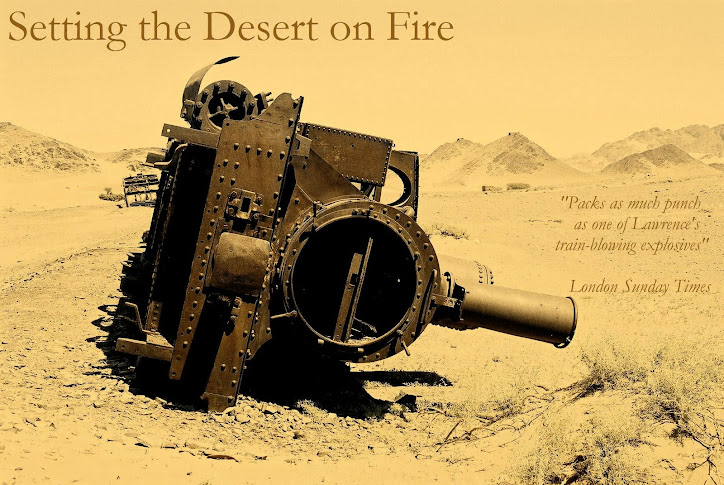I've just come across this interesting quote from Sir Kinahan Cornwallis, a British official who specialised in Middle Eastern matters. Here he is in 1931, commenting on the prospects for Iraq.
"What is going to happen when our influence is removed? My own prediction is that they will all fly at each other's throats and that there will be a bad slump in the administration which will continue until someone strong enough to dominate the country emerges or, alternatively, until we have to step in and intervene." (quoted in Peter Sluglett, Britain in Iraq, London 2007, p.210)
The situation in Iraq is now in flux and there is a sense that in the south, we have reached the finale of the British deployment. British troops in the south are now restricted to Basra Palace and the airport outside the town. Both are dangerous places, because they are attractive targets for regular mortar attacks by local insurgents eager to be able to claim the accolade of having forced the British to withdraw. Mortars are not the only threat. Conditions inside the airport base, where local contractors are also employed, are not deemed safe enough for British civilian officials to travel around without bodyguards. The focus of the British diplomatic effort is, apparently, not in improving relations with the Iraqis, but in persuading the Americans that it is time for the British to leave. Every optimistic British assessment you hear of the local authorities' determination to root out corruption, ability to run the police themselves, and so on, is designed to speed British withdrawal.
Initially proclaimed as a triumph for British "hearts n' minds" over American firepower, the south of Iraq has now become at least as unstable as the regions further north. The killing of the governor of Muthanna province this week is the latest sign that the Shia factions who 'rule' the south of the country have already started, to echo Cornwallis, "to fly at each other's throats". Muthanna had been a relatively quiet backwater, where the British passed control to the Iraqis last summer. Referring to the handover the defence secretary, Des Browne, said: "Today takes them one step nearer to assuming full responsibility for their own security and to building a stable and democratic future for their country." It does not look quite so rosy now. but there is widespread recognition that Britain has neither the forces nor the political will to stop the situation deteriorating further.
The prospect of a British withdrawal from Iraq explains the increasingly vocal American attacks on the British strategy in the south of the country, which are designed to counteract the optimistic British pronouncements that the local authorities are ready to stand on their own two feet, which are the overture to a pull-out. The American strategy to prevent a withdrawal they see as precipitate appears to be try to stir British pride by effectively accusing British troops of cowardice. Outraged British newspaper readers fired up by this slur would, presumably, demand that British troops should stay in place to prove the US wrong.
I wonder whether this rather desperate tactic will work. Surveys recently show that only a small percentage of the British public have friends and family serving in either Iraq or Afghanistan: there is a profound public lack of interest in what is happening in either, and that is clearly having a detrimental effect on British soldiers' morale in both. In this respect, note the successful intervention by the head of the army, General Sir Richard Dannatt this week to pressurise the British Royal Mail postal service into delivering parcels to troops serving in both theatres free of charge. There is little general support for the war, and many people in any case believe that British intervention in the Middle East has made further terror attacks more likely, not the reverse. In other words they may support the professionalism of Britain's armed forces while believing simultaneously that the task they have been given, in the support of the US invasion, was the wrong one. If anything, the Americans' attempt to whip up British outrage is more likely to fuel rising anti-Americanism in Britain.
For Iraqis the sad question is what will fill the vacuum once the British leave. And here it is not difficult to believe that Cornwallis's analysis of the cycle of Iraqi history remains a timeless one.
Tuesday, August 21, 2007
Flying at each other's throats
Tuesday, August 14, 2007
Digging up the recent past
At the start of this year, the Great War Archaeology Group got in touch with me. The GWAG had recently got back from excavating two sites in southern Jordan, places I had also visited during the research I did for Setting the Desert on Fire. I have the greatest respect for them. Whereas I had stopped to take a few photographs and have a look about, they had spent a fortnight under the sun, surveying and digging.
Since for me, archaeology is inextricably connected to the consumption of significant volumes of real ale, their efforts were all the more impressive since they spent their time around the town of Maan, one of the more conservative parts of Jordan, and certainly some distance from the nearest keg of beer. I was delighted to be able to help them tie down the name of the station that they had been excavating on the plain south of Maan, at Wadi Rethem (Rutm), where I had briefly stopped in September 2004.
The discoveries GWAG have made are of real interest in the understanding of the Arab revolt. They have begun to shed some light on the lives of the Turkish soldiers who were stationed along the railway, and provide evidence of the fierce fighting in April 1918 around Maan station.
For a taste of where they were, do visit their website and read their excellent report, which takes a little while to load. They return to Jordan later this year. It will be fascinating to see what more they unearth this time round.
Sunday, August 12, 2007
Bringing back the Caliphate
The BBC is reporting that 100,000 people have attended a rally organised by Hizb ut-Tahrir in Indonesia. Western intelligence and border agencies look as if they have done their best to throw the conference programme into disarray, by preventing several of the speakers from travelling to Jakarta.
Hizb ut-Tahrir - banned in many countries although not in Britain (yet) - campaigns, in incendiary terms, for the restoration of the Islamic caliphate. The caliphs were the Prophet Muhammad's immediate successors; the caliphate originally was the Middle Eastern empire that they went on to conquer in the years after Muhammad's death. With the conquest of that empire by the Mongols in the thirteenth century the caliphate disappeared. The Ottoman sultans appropriated the title from 1416 as they approached the zenith of their power. From then until the collapse of the Ottoman Empire, the Sultan was also the caliph. As the political leader and spokesman of Sunni Muslims worldwide he enjoyed a certain respect from European empires with Muslim colonies, like Britain, for the influence he was believed to wield over their subjects. The Sultan overstepped the mark in 1914, when, egged on by the Germans, he issued a call for jihad against his British, French and Russian enemies. By the time the war had ended Britain in particular was anxious for the caliphate to be wound up. By then and since, the caliphate had become firmly associated with the threat of jihad.
In fact it was the Turkish nationalists who dealt the caliphate its coup de grace. Initially they separated it from the Ottoman sultanate before finally scrapping it in 1924. The last caliph, a dignified and well-educated man named Abdul Mejid, who was a brilliant linguist and a painter, was escorted from Istanbul with two of his wives to the Greek border, from where, with only a small amount of money and "a number of jewels" he crossed Europe by the Orient Express. Photographs taken a few days later show him, dressed in a suit and fez, disconsolately taking the air in a resort on the edge of Lake Geneva. As far as the European powers were concerned, his role was, by the time of his deposition, reassuringly symbolic. As the London Times observed, by then he "had no power, even in spiritual matters; he could not issue decrees, and he was not permitted to exercise any form of patronage." He died in Paris, just as the city was being liberated in 1944.
In centuries past the caliphs took on the mantle of the Prophet. The Times, in its leader on the day after the caliph had been dismissed, wondered what had happened to that green garment. It reappeared in Kandahar in 1996, when the Taliban leader Mullah Omar appeared wearing it in public on a rooftop in the city. By doing so he was making the most open claim possible to be the caliph. A caliphate requires a caliph, and one of the reasons for the suspicion that rightly hangs around Hizb ut-Tahrir is the question of who that caliph would be.
Saturday, August 11, 2007
A brilliant and subtly subversive exhibition
 The Houghton Shahnama, courtesy of the Aga Khan Development Network
The Houghton Shahnama, courtesy of the Aga Khan Development Network



